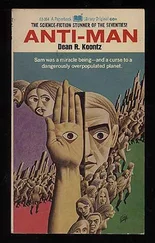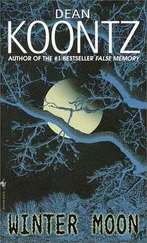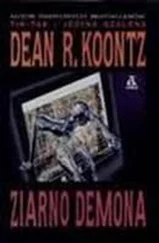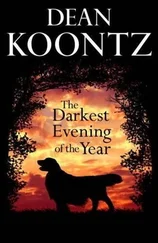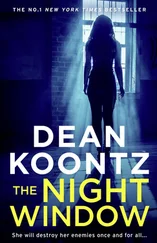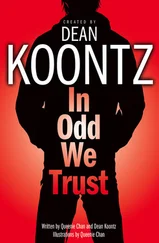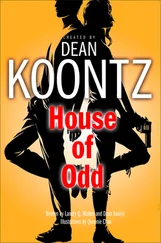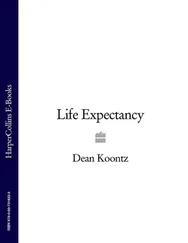In that frame of mind, he had not been a sufficiently analytical observer of the video. He’d been looking for what was manifestly not there, when perhaps he should have been studying what was to be seen.
Now he selected the first south-lawn camera recording taken at twilight, more than forty-eight hours earlier. He watched it in real time, because a lot of details flew past unnoticed in a fast-forward replay.
Again the drizzle, the slithering shapes of fog, the deodars, and the fading light provided an atmospheric backdrop against which no hooded figure appeared, though Ryan had seen it twice that night.
Something about the lazy coiling and twining of the serpentine bands of fog struck him as curious. When he reversed the twilight to watch it be imposed again upon the day, a moment came when the fog twitched . Following the twitch, the meandering mist repeated the exact movement it had made moments earlier.
He reversed a minute, pushed PLAY, and saw that a piece of the recording had been cloned to fill in for something deleted. Further in the twilight, a second piece of cloned video occurred-when the hooded intruder should have walked out of the deodars.
In the lower-right corner of the screen, accompanying the duplicated video, the timer flashed the seconds in continuous sequence, without repeating the count that went with the original segment. The hacker who had done this was a wizard with the system and a demon for detail.
For a while, Ryan reran the cloned bits-the first forty-nine seconds long, the second thirty-one seconds-thinking through the implications of this discovery.
A day had passed between the time he saw the hooded intruder and when he first reviewed the security-camera video. Someone could have tampered with it in the interim.
But last night, before reviewing the recording of this twilight, he had raced down here in pajamas and bathrobe to see who might have entered and departed the master suite to put the heart pendant on his pillow. The deletion of that person from the penthouse-landing video and the replacement of the incriminating segment with cloned images had to have been done immediately in the wake of action, as the intruder was still on the move.
This suggested that the woman with the lilies worked with at least one partner. Assuming she was the one who repeatedly violated the master suite, her backup had been tied in by computer to the security system-most likely from somewhere inside the house-busily deleting her image from video as soon as she passed out of frame.
She could no longer be considered a psycho loner. The conspiracy theory, previously a sieve, suddenly held water.
More important, the capabilities of those aligned against Ryan were impressive, and suggested depth of support.
Finally he possessed evidence. Without witnesses to the attack, he was unable to prove that the cut in his side hadn’t happened in an accident. But cloned images on a security recording couldn’t be accidental.
This was not much evidence by police standards. But he had no intention of turning to the police until he knew the motives of the conspirators-and perhaps not even then.
The woman with the switchblade claimed to want him dead, and he believed that her intention was indeed eventually to kill him. Her motive, however, remained a mystery.
The Wilson Mott operative, Cathy Sienna, had listed five roots of violence: lust, envy, anger, avarice, vengeance. She had referred to them as failings rather than motives, but they were motives all right. As with anyone intent on murder, more than one might apply.
As Ryan was about to switch off the monitor, the image on the screen flickered and changed. Instead of a view from any security camera inside or outside the house, there appeared a glistening, viscous mass, red and marbled and blue-veined and throbbing, like a menace discovered inside a cracked-open meteor in an old science-fiction movie.
For an instant Ryan had no idea what the thing might be, and then he realized this was video of a beating human heart and its attendant structures, inside an open human chest.
Although he did not touch the remote control, the screen divided into quadrants representing cameras at different locations around the estate-presenting the same gruesome video. A moment later, four other camera views flashed on the screen, all featuring the throbbing heart, and then four more, and four more…
This was not a real-time event, not a mutilation occurring on the estate, but instead an educational film of open-heart surgery. The surgeon’s hands entered the shot, and the camera pulled back to show the surgical team.
The security system cycled through all the cameras, and then again, faster and still faster, until the images passed in such a frenzy that the action in the documentary could not be followed. The monitor went dark.
From the racked array of magnetic-disk recorders in the cabinet arose the distress cries of electronics in death throes. Then silence-and on every piece of equipment, the indicator lights went dark.
Ryan didn’t need to call in tech support to know that the system had crashed, that the standard thirty days of preserved recordings had been wiped, and that he no longer possessed evidence of security-video tampering.
In the master retreat, Ryan pulled open a desk drawer, fingered through folders in a hanging file, and located the one containing the photo of Teresa Reach, which he had removed from the album in Spencer Barghest’s study.
Prior to the diagnosis of cardiomyopathy that he had received from Dr. Gupta almost sixteen months earlier, he had been convinced that in this photograph he would discover a clue that would lead him to an explanation of the strange events occurring at that time.
Ultimately his obsessive analysis of the photo revealed nothing useful. Eventually he decided there had been no conspiracy against him, no poisoning, only innocent coincidences that seemed mysterious and meaningful because of his suspicious nature and because ill health affected his clarity of mind.
Perhaps the time had come to look at Teresa again.
He no longer had the workstation that Mott had provided for the enhancement and analysis of the photograph. His unassisted eyes would have to be enough.
As he sat at the desk, the phone rang: his most private line. Caller ID provided no identity.
When he picked up the handset, the woman with the lilies said, “Review the activity in your checking account. You’ll discover you made a hundred-thousand-dollar wire transfer as a donation for cardiovascular research. I imagine a financial loss is to you more painful than a knife wound.”
Instead of playing her game, he said, “Who are you people?”
“There are not people. There is me.”
“Liar. You have institutional capabilities. Big backup.”
“Whoever I am, you’re dead.”
“Not yet,” he said, and hung up.

Be to do. Not: Be to be done to. Seize the moment. Act, don’t react. Catch the wave, shoot the curl, skeg it, nail it, don’t be nailed, exist to live, never exist to exist. Existence is an entrance, not an exit. To be or not to be is not the question.
Ryan toured the great house, turning lights on as he went, turning them off in his wake, seeing little of the rooms through which he roamed, seeing instead the place that he had come from: the roaches crawling and the roaches of another kind pinched in an ashtray, the posters of Katmandu and Khartoum, journeys never made because Dad’s daily head trips to more exotic realms take the travel money, take the rent money, so sometimes a trip to Vegas in the van, with Mom and the man, whatever man at the moment might be the man that her main man can never be, the high spirits on the eastward drive, the hard light of the vast desert and the light talk of big money, betting systems and card-counting schemes, bottles of Dos Equis to pass the miles, the groping in the front seat while in the back of the van you pretend deafness, pretend sleep, pretend death, pretend never to have been born; sometimes being left alone in casino parking lots at night, hiding in the back of the van because when you sit up front where you can be seen, strange people rap on the window and sweet-talk you-vampires, you figure-and try to get you to unlock the door, and then the cheap motel, always the same cheap motel, where you wait in the van while Mom and the man of the moment spend “quality time” together; a day later or two, the drive westward, the desperate talk about money, the bitter accusations, the rest stop where one of them hits her and she hits back, and you try to stop it, but you’re small and weak, and then he does something to her right there in the open, and you have to walk away, away into the hot dry land, walk toward home, you can’t watch, but you can’t walk hundreds of miles, so when they pull up beside you in the van, you have to get in the back, and they’re up front laughing, like nothing happened, and then it’s all the way home, the desert without beauty in this direction, the Mojave a vast dirty ashtray, Mom and the man talking about the next time, scoring big the next time, refine the system, practice the card counting, all the way home to Dad and Katmandu and Khartoum and the roaches and the roaches and the next man of the moment.
Читать дальше
Конец ознакомительного отрывка
Купить книгу


